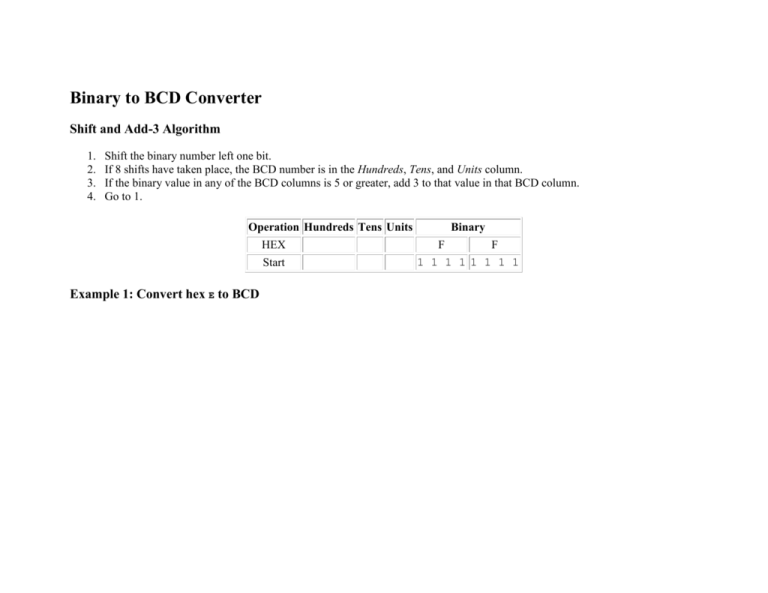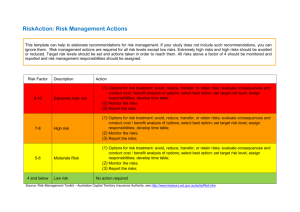Binary to BCD Converter
advertisement

Binary to BCD Converter
Shift and Add-3 Algorithm
1.
2.
3.
4.
Shift the binary number left one bit.
If 8 shifts have taken place, the BCD number is in the Hundreds, Tens, and Units column.
If the binary value in any of the BCD columns is 5 or greater, add 3 to that value in that BCD column.
Go to 1.
Operation Hundreds Tens Units
HEX
Start
Example 1: Convert hex E to BCD
Binary
F
F
1 1 1 11 1 1 1
Example 2: Convert hex FF to BCD
Truth table for Add-3 Module
Here is a Verilog module for this truth table.
module add3(in,out);
input [3:0] in;
output [3:0] out;
reg [3:0] out;
always @ (in)
case (in)
4'b0000: out
4'b0001: out
4'b0010: out
4'b0011: out
4'b0100: out
4'b0101: out
4'b0110: out
4'b0111: out
4'b1000: out
4'b1001: out
default: out
endcase
endmodule
<=
<=
<=
<=
<=
<=
<=
<=
<=
<=
<=
4'b0000;
4'b0001;
4'b0010;
4'b0011;
4'b0100;
4'b1000;
4'b1001;
4'b1010;
4'b1011;
4'b1100;
4'b0000;
Binary-to-BCD Converter Module
Here is a structural Verilog module corresponding to the logic diagram.
module binary_to_BCD(A,ONES,TENS,HUNDREDS);
input [7:0] A;
output [3:0] ONES, TENS;
output [1:0] HUNDREDS;
wire [3:0] c1,c2,c3,c4,c5,c6,c7;
wire [3:0] d1,d2,d3,d4,d5,d6,d7;
assign d1 = {1'b0,A[7:5]};
assign d2 = {c1[2:0],A[4]};
assign d3 = {c2[2:0],A[3]};
assign d4 = {c3[2:0],A[2]};
assign d5 = {c4[2:0],A[1]};
assign d6 = {1'b0,c1[3],c2[3],c3[3]};
assign d7 = {c6[2:0],c4[3]};
add3 m1(d1,c1);
add3 m2(d2,c2);
add3 m3(d3,c3);
add3 m4(d4,c4);
add3 m5(d5,c5);
add3 m6(d6,c6);
add3 m7(d7,c7);
assign ONES = {c5[2:0],A[0]};
assign TENS = {c7[2:0],c5[3]};
assign HUNDREDS = {c6[3],c7[3]};
endmodule
General Binary-to-BCD Converter
The linked code is a general binary-to-BCD Verilog module, but I have not personally tested the code.
Reference: course materials from Prof. Richard E. Haskell
Maintained by John Loomis, last updated 4 Jan 2004





![[slides] Tomasulo's algorithm](http://s3.studylib.net/store/data/009667655_1-131b0456ada613df64c5c90f7e9e772c-300x300.png)